Or Ogni Porikkha, if you want to be phonetically correct.
Over the last twenty-odd years, I’ve heard countless Bengalis rave about Uttam Kumar and Suchitra Sen as the ultimate onscreen romantic couple. I’ve seen both of them act (separately) in a few (admittedly Hindi) films, and have been very impressed.
So, finally: an Uttam Kumar-Suchitra Sen film, and one that was a big hit too. Agni Pariksha: ‘trial by fire’.
The story begins in the house of Mr Banerji (Kamal Mitra, identified by Sharmi—I need help identifying the cast in this film! The only people I can recognise are Uttam Kumar and Suchitra Sen). Mr Banerji and his wife Chitra (?) are off to visit her aunt in Mussoorie, while Mr Banerji’s elderly mother (?) is taking her three grandchildren—Mr Banerji’s offspring—with her to their ‘ancestral village’, their hometown.
The three children, the teenaged Tapasi (?) and her younger brothers Siddharth ‘Siddhu’ (?) and Amitabh ‘Amit’ (?)—whoever heard of Bengali boys with pet names that were such civilised contractions of their actual names?!—are excited at the thought of going off with Grandma. Tapasi, in fact, decides to borrow some of her mother’s saris on the sly, so that she can wear them in the village. Frocks and skirts, as she tells her father, will be so out of place in the village.
Chitra is not at all happy that her mother-in-law is taking the children to the village. Her mother-in-law is, in any case, not a big favourite with Chitra: Chitra thinks the old lady’s a stick-in-the-mud with fuddy-duddy ideas that belong in the 10th century. The fact that Mr Banerji’s father left all his vast wealth to his widow rather than to Mr Banerji just makes Chitra even more bitter.
Anyway, Chitra and Mr Banerji go off to Mussoorie, while Grandma arrives in the village with Tapasi, Siddhu and Amit.
Here, an old friend of the family, Mr Kanti Mukherji (?), invites Grandma and the children over to his home for some religious ceremonies centring round the installation of some idols. The group lands up at Kanti Mukherji’s palatial home (he’s the area’s wealthiest zamindar, a multi-millionaire landowner who’s highly respected). Mr Mukherji takes one look at Tapasi—who’s dressed up in her mother’s wedding sari for the occasion—and is immediately enchanted.
While the children go off to participate in the festivities, Mr Mukherji asks Tapasi’s Grandma for Tapasi’s hand in marriage to Bulu (?, he at least conforms to the principles of pet name selection!), Mr Mukherji’s grandson and his sole surviving heir. Bulu is summoned, and is introduced to Grandma; it turns out he’s studying at the Presidency College in Calcutta.
Grandma is rattled by Mr Mukherji’s proposal, but he uses emotional blackmail to finally get her consent. In any case, says Mr Mukherji: it’s not as if Tapasi and Bulu will get married right now; only when they’ve grown up.
The festivities over, Grandma and the children have gone back to their own home when a servant comes to fetch them back to Mr Mukherji: he’s dying (he’d admitted earlier that he has cancer). They arrive, and Mr Mukheri springs a surprise: he wants Tapasi and Bulu married, now. Before he dies.
Grandma is easily swayed, and before they know it, Tapasi and Bulu are married, and Mr Mukherji is dead.
Tapasi’s father arrives in response to his mother’s telegram to him and is flabbergasted to find his little girl married. He takes her back to Calcutta, where Chitra—hastily summoned—arrives, to rave and rant and swear that she’ll wipe out all signs of Tapasi’s idiotic marriage.
This traumatic incident has many fallouts. A grieving Grandma bequeaths her entire wealth to Tapasi, whilst allowing Rs 500 to be sent every month to Banaras, where Grandma now retires.
Tapasi herself seems to have settled back into life as an urban schoolgirl. The only problem is that when she absently scribbles in her notebook, she goes on writing Bulu’s name. And she’s keen on learning how to drive; in fact, just the other day, she’s been on a drive all the way to Presidency College…
…where, though she hasn’t met him since their disastrous wedding, Bulu too is thinking of Tapasi, absently writing her name when a friend asks him to test a new fountain pen.
But then, disaster strikes again. Mr Banerji, plagued by sorrows and by Chitra’s incessant nagging, has a heart attack and dies.
12 years pass, and the next we know, Tapasi (now Suchitra Sen) is holidaying in Mussoorie, staying with her siblings and her mother at the house of Chitra’s aunt and her daughter Lily (?). One day, Tapasi’s out in the hills by herself when she meets a stranger (Uttam Kumar).
His name’s Kirit Mukherji, and he’s a sweet, gentle man who tells her that the fog’s so thick, she’d better stay put until it clears. Which, of course, could take hours. Tapasi agrees, and when he asks her if she’s the well-known singer Tapasi Banerji (yes, Tapasi’s made a name for herself in the years gone by), she admits to it, and even obliges him by singing a song.
Back home, Tapasi finds herself the object of much envy. Her ‘aunt’ Lily is openly jealous that the very wealthy, well-travelled Kirit Mukherji (who’s lived abroad for the past 10 years and has only recently come to Mussoorie) spent 2 whole hours with Tapasi. Lily’s mother tells Tapasi that Tapasi must introduce the entire family to Kirit—in the hope, obviously, that Kirit will fall for Lily. Tapasi’s mother is happy.
And who wouldn’t be? Over the days that follow, Tapasi becomes increasingly friendly with Kirit. They spend a lot of time with each other, wandering in the hills, talking, Tapasi singing and Kirit listening.
Tapasi tells Lily that she isn’t in love with Kirit; but all evidences point to the contrary. Especially when Tapasi gets a telegram summoning her to Calcutta—and visits Kirit late that evening to bid him farewell for the time being. Doesn’t this mean something more than mere friendship? Kirit thinks so, and from the note that Tapasi leaves for him (giving him her address in Calcutta) it seems she thinks so too.
Kirit moves to Calcutta, and is invited to a party at Tapasi’s home. He’s a hit with Tapasi’s friends, and when he invites them to an outdoor party he’s hosting, everyone gladly agrees.
Kirit’s party turns a bit sour when a bunch of hooligans, leering at all these fashionable women, tries to gatecrash the party. Kirit shows a bit of muscle and shoos off the miscreants, winning himself much praise—and Tapasi’s thinly-veiled affection. She makes it pretty obvious that she is in love with Kirit, and he reciprocates.
Later that evening, though, things turn topsy-turvy. Kirit is driving Tapasi home, and has to stop the car along the way to allow a marriage procession to pass. Tapasi, looking out at the bride and groom—both mere teenagers—recoils in horror, suddenly reminded of her own long-ago wedding.
Bulu. Kirit. Husband. Beloved. The past. The present. Which will Tapasi choose?
And oh, the symbolism. Like Sita and her agni pariksha, Tapasi (very aptly named; ‘tapasi’ means ‘she who does penance’) Tapasi too ends up going through the flames of misery in order to emerge, hopefully, unscathed. Tapasi’s misery—her tormented existence, caught between a husband she doesn’t know, and a man who means the world to her—is, like Sita’s, not of her own making; it is the result of external forces. In Tapasi’s case, her grandmother’s and Kanti Mukherji’s ludicrous decision, followed by Chitra’s obstinate refusal to accept the marriage. But it is Tapasi, eventually, who must atone for all their sins too and face up to her destiny.
This isn’t a path-breaking film (in fact, it can be considered pretty regressive in its condoning of child marriage), but it’s entertaining, and if you’re at all a lover of romances, there’s plenty here to leave you dewy-eyed. Very pretty.
What I liked about this film:
Uttam Kumar and Suchitra Sen. Include me in the Uttam Kumar-Suchitra Sen fan club, guys! These two are so good together. They look perfect, but more than that, it’s the chemistry between them—the playfulness and affection, the understanding, the emotional bonding, the passion… what more could one want from a convincing romantic couple onscreen? Superb.
The music. Lots of lovely songs here, though my favourites are Gaane mor kon indradhanu and Aaj achhi kaal kothai (why does the latter sound familiar? Is there a similar tune in Hindi cinema?)
What I didn’t like:
The entire premise of the film—the justification of child marriage, that it is all right for people to be pushed around and their lives changed irrevocably simply because they happen to be too young to fend off elders who’re “doing it for your own good”. Ugh. Not nice at all.
Some inexplicable flip-flops that characters do in the course of the film. For instance, Amit seems neutral towards Tapasi’s relationship with Kirit through most of the film; then, in one scene, he spews venom and seems to disapprove thoroughly; and the next time we see him, he’s back in Tapasi’s camp. And towards the end of the film, another character does a sudden and unconvincing about-turn that had me rolling my eyes.
Little bit of trivia:
Agni Pariksha was a big hit the year it was released. Its success prompted Uttam Kumar to, 13 years later (didn’t anyone tell him the number 13 is supposedly unlucky?!), remake it in Hindi as Chhoti si Mulaqat. He produced the film, which was directed by Alo Sircar and starred Vyjyantimala opposite Uttam Kumar. Chhoti si Mulaqat was a resounding flop and nearly bankrupted Uttam Kumar.
Comparisons, comparisons:
So how does Agni Pariksha compare with Chhoti si Mulaqat? Which is better? And why, possibly, did Chhoti si Mulaqat sink so badly while Agni Pariksha was such a hit?
Some thoughts.
Considering that 13 years (and what seems to be a fair bit of money) separated Agni Pariksha from Chhoti si Mulaqat, it’s hardly surprising that the latter wins in the more superficial details: more glamorous and obviously more expensive. The scenes in Shimla, for instance, are definitely shot there, on ski slopes and green hills; Agni Pariksha’s outdoor scenes are pretty obviously against backdrops painted with hills.
But other than that advantage, Chhoti si Mulaqat falls well behind Agni Pariksha. For instance, its hero, Ashok, is not half as likeable as Kirit. Ashok is rather more the typical Hindi film hero of the 60’s (and to some extent the late 50’s): a self-assured, conceited young man who relentlessly pursues a girl until she cracks. Ashok’s pursuit of Rupa in fact almost smacks of stalking at times. And he emerges, ultimately, as a somewhat manipulative and self-centred individual whose actions are governed to a large extent by concerns other than his love for Rupa.
Kirit, on the other hand, is portrayed as a caring, warm gentleman. His relationship with Tapasi is emphatically not of pursuer and pursued; I could easily relate to why Tapasi would fall in love with a man like this: he’s understanding, kind, and doesn’t try to bully her into loving him. And his actions, as he finally reveals, stem largely from his love for Tapasi. On the whole, a far more mature man than Ashok.
Agni Pariksha is like that too: more evolved than Chhoti si Mulaqat, more progressive. That child marriage motif is there, of course: but it is suppressed by the highlighting of Tapasi and Kirit’s relationship, which becomes the central focus of the film. Chhoti si Mulaqat goes overboard when it comes to the revelation of Rupa’s past, what with everybody ostracising her. Similarly, the emphasis on a wife being forever bound to her husband—even if merely in name—gets tedious in Chhoti si Mulaqat, with Rupa being lectured (even by Ashok himself) on how nobody can come between a man and his wife—not even if the husband beats the wife, as they witness one day when a fisherwoman is abused by her husband.
Agni Pariksha has more to recommend it. Though there are frequent mentions of how a Hindu woman, bound by the shastras to her husband, must always remain his, there is Kirit’s gentleness, Grandma’s own (occasional) remorse, and—most importantly—Kirit and Tapasi’s love story, to balance it. There is also the fact that Agni Pariksha is uncluttered when compared to Chhoti si Mulaqat: it has no irritating comic side plot and no vicious vamp (though Lily does pass some snide remarks) vying for the hero’s affections. And there is the fact that both Tapasi and Bulu are more adolescents than children when married—old enough to be infatuated with each other, even if not in love.
My theory is that this somewhat more balanced approach, and the superb chemistry between Uttam Kumar and Suchitra Sen, was what made Agni Pariksha a hit. Also perhaps the fact that this was more than a decade older than Chhoti si Mulaqat—India, I assume, had moved on by 1967 and was less amenable to seeing films that glorified child marriage.
If you want to watch Agni Pariksha online, it’s available (with English subtitles) on youtube, starting with part 1.


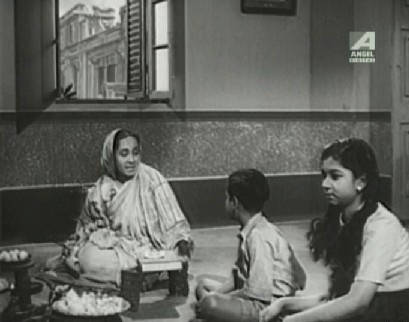
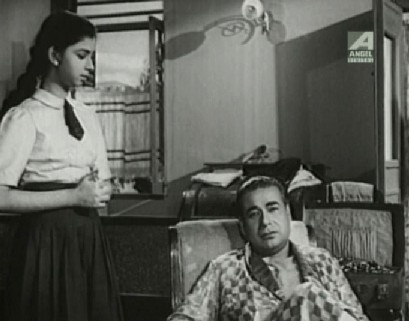





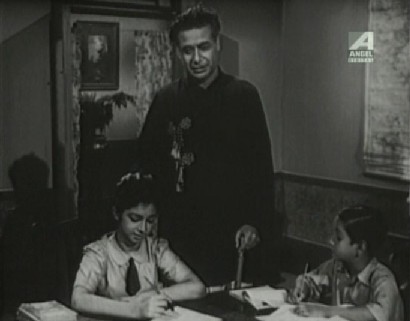
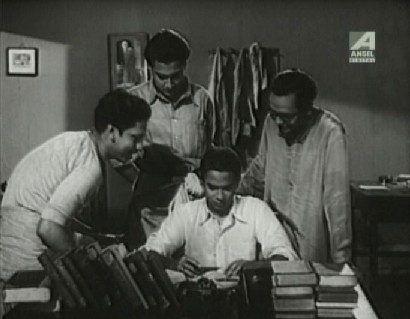
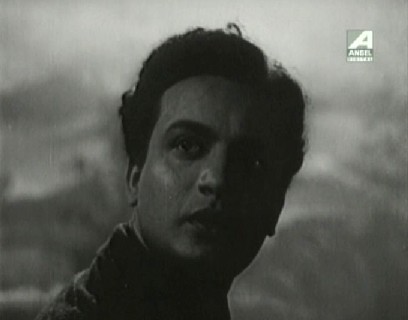







This does sound a whole lot better than Chhoti Si Mulaqat with its stalker “love” story and its determinedly male-chauvinist outlook. A really good romance is enough to make me forgive the child-marriage aspects of it. :-) Speaking of child-marriage in Bollywood movies – wasn’t Balika Badhu one such? I vaguely remember a young Sachin singing Bade achhe lagte hain to his equally young bride.
Back to Uttam-Suchitra – considering how believably they conveyed romance on-screen (for over 20 years, in more than 30 films!) isn’t it interesting that they never actually got together in real life?!
LikeLike
Agni Pariksha is definitely a lot more progressive as a film than Chhoti si Mulaqat – ironic, considering it was made so much earlier! Kirit even tries to ‘tell’ Tapasi a few times, but she forces him to keep quiet, unaware of what he has to say. He’s a much, much more endearing character than Ashok. For anybody who likes romance, I’d certainly recommend this.
I haven’t seen Balika Badhu, but I remember Bade achhe lagte hain: such a lovely song. Incidentally, another very unlikely candidate for the child-marriage element is Sahib Biwi aur Ghulam: it eventually turns out that Jaba and Bhootnath had been married to each other when they were children, so falling in love was such a happy accident!
What excellent actors Suchitra Sen and Uttam Kumar were, right? To have never got on offscreen, but to have been so good onscreen – that takes some doing. They’re so convincing, it’s a pleasure to watch!
LikeLike
Hey, you’ve written about a very famous Bengali film, a film that most of our parents dote on. Yes, I’ve seen it too. Mr Banerji in the film is Kamal Mitra. He was a very famous character actor those days. There are so many films featuring Uttam-Suchitra as the lead and they are so good!! Welcome to the Uttam-Suchitra lovers club!! Why don’t you try Chawa-Pawa, Pothey Holo Deri and Harano Sur. Very nice films…Great post!!
LikeLike
Sharmi, thank you so much for all those recommendations! (and thank you for identifying Mr Banerji for me).
Fortunately for me, Seventymm, the DVD rental company I subscribe to, has Pothey Holo Deri and Chawa-Pawa on their catalogue, so as soon as I’d finished watching Agni Pariksha, I put those on my wishlist too. Harano Sur has been recommended to me by a whole bunch of other people – including Tom Daniel, who did the work on that Johnny Walker songs compilation DVD – but Seventymm don’t have that with them. I guess I’ll probably have to order it from Induna.
LikeLike
You know there are a host of films that these two actors did together. For instance, Sagarika (not very great). Oh, I forgot Saptapadhi….It’s simply superb. Watch it for Suchitra..she plays an anglo-indian over there. The films starts on a light note and then gets serious!!! Amazing performance by Chhabi Biswas also (he plays Uttam’s dad). Biswas was even bigger than Kamal Mitra. I’ll tell you of a very enjoyable Uttam-Tanuja film with great songs…Dewa-Newa…It’s a jolly good musical..watch it :)
LikeLike
I saw Chotti si Mulaaqat quite a long time back and I didn’t like itmuch that time.
In Agni Pariksha it seems though the marriage is showed in a better light or let us say it sounds more plausible. Both are teenagers and such. And also that they seem to love each other at time.
But I think would still have qualms like you when watching it.
How is the music? Chotti si Mulaqat had some good music.
LikeLike
BallikaBadhu is also a story of child marriage, but the story takes place during the British Raj,w hen such things were quite common, but it doesn’t propogate it as a desirable marriage form. I thinkk it was done in quite a sensible manner.
LikeLike
Sharmi: Deya Neya is already on my wishlist! As soon as I saw that the cast included Tanuja, I decided I had to see it. Looked for Saptapadi as well – Tom had recommended that too – but guess I’ll have to get it from induna. So many films, so little time…
harvey: This one’s much better than Chhoti si Mulaqat, more mature and with less emphasis on the ‘tradition’ stuff – the grandmother and the father (while he’s alive) try to say a bit about that, but otherwise the film focuses on the Tapasi-Kirit relationship, and (towards the end of the film) Tapasi’s internal struggles. Best of all, as I mentioned in the review, is the character of Kirit – he’s a very nice person. Plus there’s the fact that Tapasi and Bulu are anyway old enough to feel something for each other; (they’re actually the same age as Rupa and Ashok were when they got married, but then maybe ‘childhood’ in 1954 ended earlier, figuratively, than childhood in 1967).
Oh, and the music is very good!
BTW: Another film that deals with child marriage is the Joy Mukherji-Rajshree starrer Ji Chahta Hai. Very good music, but a very avoidable film!
LikeLike
I ahtwe watching movies on youtube as it does my back in, i have a desktop not a lap top but i might just brave this one out sometime, AS I WANT TO SEE HOW IT ALL ENDS, its nice to see some of these film companies are uploading movies wth Eng subs for free.
I absolutely love Suchitra Sen ‘Is mod se jaate hain’ from Aandhi comes to mind when i think of her, such a gorge song and one of my all time fave Lata numbers
LikeLike
It seems a lot of films were more “progressive” in tone early on than they became in the 60s and 70s :) Ah well. Everything is a cycle. I have a couple of Suchitra Sen-Uttam Kumar films to watch, must get to them!!!
LikeLike
bollywooddeewana: Yes, prolonged sitting in front of a desktop can really mess up your back! My laptop has a 17″ screen, so almost counts as a desktop – but we went and got a special ergonomically designed chair, so I have no problems sitting at it for over 8 or 9 hours a day.
I love Suchitra Sen too. Among her earlier films, a few I’d recommend are Devdas (though depressing, she at least has a good role); Bombai ka Babu and Mamta. The latter has fantastic songs too – especially Rahein na rahein hum and Rehte thhe kabhi jinke dil mein.
memsaab: Pehchaan certainly sounded way more regressive than a lot of films that were made before 1970!! Tom sent you Harano Sur and was it Saptapadi…? He did mention it to me. I believe Harano Sur is a remake of the Ronald Colman-Greer Garson hit Random Harvest. Very highly praised by all my Bengali friends and relatives!
LikeLike
This sounds good. I haven’t seen Chhoti Si Mulaquat . So I guess I’ll go ahead with this rather than the Hindi version. I have heard lots of people rave about Uttam-Suchitra chemistry…so really wanted to see them together at least in one movie.
Whoever heard of Bengali boys with pet names that were such civilised contractions of their actual names – ROTFL
LikeLike
Hehe! sunheriyaadein, I was wondering if anyone would bother to read that link! :-) It’s so cute – and so true. I am part Bengali, plus my sister is married to a Bengali, so I have platoons of relatives and ‘connections by marriage’ with the most outlandish pet names! The worst was when I had accompanied my sister and brother-in-law to Kolkata, and my brother-in-law took us to meet one of his cousins. The man is very well respected, a judge in the Calcutta High Court, but was introduced to me by his (very weird) pet name! I couldn’t bring myself to even address him by the name. Only learnt much later that his actual name is a very dignified one…
LikeLike
Yeah…I remember you mentioning the judge – Doddy uncle, right? ;-)
We had discussed about bengali nicknames sometime back here –
https://dustedoff.wordpress.com/2009/10/30/samadhi-1950/
LikeLike
Bingo! Yes, Doddy Uncle. :-) And we have everybody from a Gulgul to a Gaga to a Gudul in the family. People with otherwise absolutely normal, often very dignified names, but everybody knows them only by their completely crazy pet names.
LikeLike
Actually, in a way, it doesn’t support child marriage – just the sanctity of marriage once it is done. The hero says he did not want to claim the heroine by dint of the past; he did want to gain her acceptance and love by dint of who he is now.
I wouldn’t call that a progressive agenda, but still.
The main thing about the movie (and other Uttam Suchitra movies) is how much empathy they show for each other. Since they are so convincing, one comes back with the conclusion that they are really good at their craft.
LikeLike
hey,back after a long time.was going through some really bad times,so could not keep in touch.
well,you must watch Harano Sur,even though it has plot similarities with random harvest.The reason you should watch Harano sur is because it’s way better than Random Harvest [I’ am saying this after watching both the films.].Anyways,the fact that a film is a remake should never deter one from watching the film.After all, Saheb Biwi Aur Ghulam,Chupke Chupke,Bawarchi,Mere Apne,Angoor,Padosan,Prempatra,Safar,Khamoshi,Kala Pani,Hum Dono,Mamta,Kabuliwala etc are all remakes of Bengali originals,but that does not stop us from watching,loving and appreciating these hindi films.
LikeLike
Hi Raunak, good to have you back here! I hope things have settled down for you now.
I agree completely with you regarding remakes – just because a film is a remake (which can be, in some ways, I think a possibly good way of sharing a fine story with a wider audience) – doesn’t mean that a remake must be avoided. I must admit that other than Agni Pariksha, I’ve not seen the originals of any of the films you’ve named, but I’ll keep an eye out for it. I’ve especially been wanting to see Harano Sur – but, oh – if only I could find the time to first finish watching the heap of DVDs I already have at home!
LikeLike
I am a fan of Suchitra Sen Uttam Kumar fan since seeing them in Pothe Holo Deri. What a lovely heartwarming pair. Since then I have seen them in Agnipriksha, ChawaPawa. Shap Mochan, Harano Sur, Shilpi, Deep jole jay, Sagorika, SabarUparey, Sare Chuhatar etc. Nexttime I am in Kolkata I wish to pay respects to this legend of bangla cinema. I donot tire of seeing this pair’s movies.
LikeLike
I have been really wanting to watch Sagarika – I loved the Hindi remake of it (Prem Patra), so I am certain I’ll love the original too. Plus Harano Sur and Deep Jele Jai… all have been recommended to me. Chaowa Pawa I enjoyed a lot, and Saare Chuattar is lying in my to-watch pile. Will get around to it someday soon! Uttam Kumar and Suchitra Sen are really a joy to watch. :-)
LikeLike
When you look at the bengali movies of those times (or even these times) look for the directors, Uttam and Suchitra had many bad (in my opinion, which may differ) , say Shapmochon, even Bipasha I consider average (but that is biased since I had read the novel, and then that had affected my judgement by comparison) movies too. Ajoy Kar, Agradoot, etc few had superbly used their capabilities.
Uttam as any Bong would say is once in a history legend. Of the heroine, I flipflop between Suchitra and Sabitri with excellent movies there too Marutirtha Hinglaj (a Classic with capital C or may be all-caps), Nishipadma etc come to mind). I am not sure how many are there with subtitles. If I go for equivalence, Suchitra=Madhubala and Meena Kumari= Sabitri
LikeLike
Thank you. You’ve actually enlightened me quite a bit, so I’m grateful for that. Especially since I don’t really recall seeing any of Sabitri Chatterjee’s films (though I have heard of her, obviously). Must amend that soon, perhaps with one of the films you suggest. I just hope I can get one with subtitles.
LikeLike
Sabitri is part of the famous Triple-S heroines of Uttam (Suchitra, Sabitri, Supriya). Sabitri of these may be the most talented. Marutirtha Hinglaj I could see in Youtube to be in subtitled. The DVD of course too is with probably with subtitle, but since I keep the feature off, it distracts, so I can’t guarantee. There are certain excellent ones with Kaberi Bose (Shayamali, Ami Se O Sakha), Anjana Bhowmick (Nayika Sambad- excellent movie but equally poor print both in You as well as the official DVD) . Difficult to list them all.
LikeLike
Thank you! Will look for the films you’ve suggested. Failing all else, I’m pretty sure Induna will have the subtitled DVDs of these films – they invariably do.
LikeLike
My DVDs are usually from Induna, because of their huge collection and also because of the service and behavior.Very prompt in replacement and sometime they even go overboard (don’t even wait to get the defective back, add the replacement in my next order). There are some other plus points I saw there – in case of repeated errors in a product, they have withdrawn the disc from catalog etc which shows a customer-centric approach that I didn’t find Biggies doing. Only when a disc isn’t available with them and available elsewhere would I go out. A few times I suffer , currently I am waiting for my delivery from another supplier for an order of 7th, a simultaneous (next day) from Induna has been already delivered and watched.
LikeLike
I haven’t ordered that often from Induna, but whenever I have, the experience has been very good. Very professional, very prompt and responsive. Others should learn from them!
LikeLike
And with a Bong touch. The names don’t show them to be Bong though but they have made a “dada” of me (I would be more of a “Kaku” or “Jethu” – the uncles :-) in age. Hence a warning, if you become regular, you can soon be made a didi.
LikeLike
Hehe. Or, once they discover my age, possibly a pishi. ;-) At the very least, a kaki.
LikeLike
Just saw this film now, and I must admit the romance scenes between Uttam and Suchitra made me yawn. And the part where Kirit turns out to actually be Bulu was fairly predictable. However, it was quite a welcome break after watching all those Tamil / Malayalam artsy stuff. Plus, I must say that it was interesting watching Uttam Kumar’s first blockbuster.
LikeLike
“However, it was quite a welcome break after watching all those Tamil / Malayalam artsy stuff. ”
You have me at a disadvantage, there. The only artsy Malayalam or Tamil film I’ve seen has been Chemmeen. Such a paucity of old films that are subtitled. :-( Bengali films seem to be more easily available with subs.
LikeLike
Try einthusan.com, that’s a place where you can watch several subtitled movies of Tamil and Malayalam. And the artsy movies that I am talking about are all pretty much from this decade. Most of the South Indian movies from the 60s are more or less Shammi Kapoor kind of films, with the only difference being that their far more gaudy and louder lol.
LikeLike
I tried einthusan.com, but it’s been blocked. :-( Such is life.
LikeLike
You made me intrigued with your statement about artsy Tamil/Malayalam movies. Intrigued in reference to which decade they were made. Because from what I have seen, artsy movies in both Malayalam and Tamil didn’t really take off before 70s with the exception of two movies directed by Nimai Ghosh & Jayakanthan respectively(Cheemeen and Thulabhram were more middle of the road stuff, following in the footsteps of the likes of great Tapan Sinha, Agragami & co from Bengal).
Also, Agnipariksha wasn’t the first Uttam blockbuster. He already had two in Basu Paribar & Sharey Chauttor (both directed by Nirmal Dey) before Agnipariksha burned the screens in 1954.
LikeLike
Watch “Agni Pariksha – Bengali – 1954 – Uttam, Suchitra” on YouTube
..
Nice review madam. I just wanted to share the nice upload of the film by tommydan55 with english subtitles.
LikeLiked by 1 person
Yes. Tom’s doing a great job cleaning up these films and getting people to subtitle them.
LikeLike